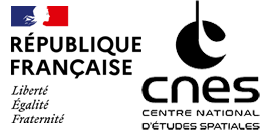Partner communities
On October 15, 2020, COMET-ORB organized a seminar on the latest advances in atmospheric modeling for space mechanics issues.
The prediction of the atmosphere behavior is a crucial problem for the calculation of satellite trajectory, so COMET ENV and OPS have joined for this seminar on this topic.
Program :| Start | Timing | Title | Speaker |
|---|---|---|---|
| 09:00 | 30' | Introduction | JLV, GG, MR (COMET) |
| 09:30 | 30' | Review of magnetic activity indices | Aude CHAMBODUTISGI (EOST, Université de Strasbourg/CNRS) |
| 10:00 | 30' | Which solar inputs for the specification of the upper atmosphere ? | Thierry DUDOK DE WIT (LPC2E, CNRS/CNES/Université d'Orléans) |
| 10:30 | 15' | Pause | |
| 10:45 | 30' | The need for data in atmospheric models | Sean BRUINSMA (CNES) |
| 11:15 | 30' | The problem of the upper atmosphere in mission analysis (problems, state of the art and perspectives) | Hugo VEILLEZ, Nicolas TCHINTCHARADZE (CNES) |
| 11:45 | 120' | Lunch break | |
| 14:00 | 30' | Experience at ESOC in orbit determination and on-going research in drag modeling | Pere RAMOS (ESOC) |
| 14:30 | 30' | Testimonies and RETEX operations related to space weather | Séverine BELLOIR (CNES) |
| 15:00 | 30' | The ESA Space Weather Service Network Products and Services Supporting Atmospheric Drag Calculation: Current Capabilities and Outlook | Alexi GLOVER (ESOC) |
| 15:30 | 60' | Round table | |
| 16:30 | End |
Review of magnetic activity indices Aude CHAMBODUTISGI (EOST, Université de Strasbourg/CNRS)
A great number of Space Weather applications rely on historical geomagnetic activity indices (ISGI, http://isgi.unistra.fr). They represent unprecedented homogeneous time series, up to more than 150 years, highly valuable for all studies related to long-term geomagnetic activity but remain limited in temporal and spatial resolutions.
In this presentation, I will give a brief overview of IAGA-endorsed magnetic activity indices then focus on possible mitigations of historical indices' drawbacks, finally present new developments.
Which solar inputs for the specification of the upper atmosphere ? Thierry Dudok de Wit (LPC2E, CNRS/CNES/Université d'Orléans)
A recurring problem in specifying the upper atmosphere is the choice of proper solar inputs. Proxies of solar radiative forcing are often preferred to direct measurements because they offer better stability and coverage over time and therefore are better suited for operational use. However, each of them has drawbacks.
In this presentation, I will give a brief overview of the main solar inputs, then focus on their relevance to upper atmosphere modelling, present recent advances in predicting these indices, and finally discuss their availability in the coming years.
The need for data in atmosphere models Sean BRUINSMA (CNES)
The semi-empirical thermosphere models DTM2020 and the density database used in its construction will be shortly reviewed, as well as the choice of the indices selected to drive the models. Different sources of error hamper progress in thermosphere modeling and prediction. These will be shortly discussed and illustrated, possible solutions will be presented, and a way forward, notably by means of developing an operational observing system.
The problem of the upper atmosphere in mission analysis (problems, state of the art and perspectives) Hugo VEILLEZ, Nicolas TCHINTCHARADZE (CNES)
The drag acceleration is one of the main contributors of the position prediction uncertainty in low earth orbits. This uncertainty affects both the station keeping efficiency and the collision risk management.
This lecture presents the working axes that have been and will be explored in the flight dynamic department to improve the drag acceleration predictions.
Experience at ESOC in orbit determination and on-going research in drag modeling Pere RAMOS (ESOC)
ESOC current fleet covers 16 Earth orbiting satellites at different altitudes. The lower the satellite is, the higher the effect of the drag becomes, and the larger the uncertainty it faces in predictions. This presentation will cover the experience of ESOC in orbit determination and how it deals with the uncertainty of some of the lower missions (such as AEOLUS, at 320 km). It will also cover some of the on-going research in drag modeling, solar activity and drag coefficient predictions.
Testimonies and RETEX operations related to space weather Gérard GALET & Séverine BELLOIR (CNES)
The objective of this presentation will be to give the point of view of the operators on the subject of the orbitography of our satellites, to recall our operational priorities, to underline pro & cons in this orbital management based on our experience. We will take the opportunity to also raise some questions that we ask ourselves in relation to the future. It is therefore a point of view of end user that we will propose to you.
The ESA Space Weather Service Network Products and Services Supporting Atmospheric Drag Calculation: Current Capabilities and Outlook Alexi GLOVER (ESOC)
TBD
A round table discussion is planned at the end of the seminar to exchange on the issues of index prediction and future research in the field.







